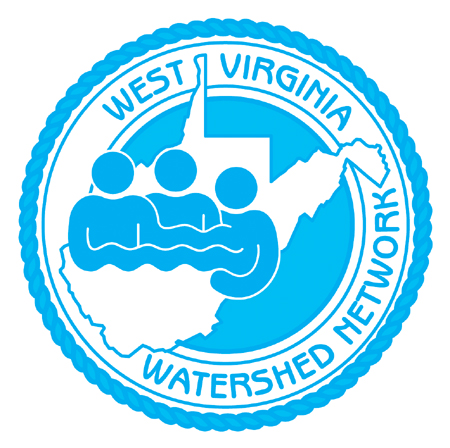 | | | WV WaterNet: Winter Edition | | | | | | The West Virginia Stream Partners Program Awards Grants for 2022 | | West Virginia’s Department of Environmental Protection, Division of Natural Resources, Division of Forestry and the Soil Conservation Agency are proud to announce the 2022 WV Stream Partners grant awards. The grants are given to watershed associations interested in working with the agencies to create partnerships and develop stream improvement projects to protect and restore their local streams and rivers. This year 19 organizations received funds up to $5,000. “The WV Stream Partners Program continues to be a success because of the volunteers and watershed association staff who work tirelessly for clean water and to enhance recreational opportunities for our state.” says Jennifer Pauer, Stream Partners Program coordinator. This year’s grants will support tree plantings, litter awareness campaigns, wetland restoration, stream access, water trails and much more. Many watershed associations use these funds to match larger projects such as the planning and monitoring of acid mine drainage treatment projects and natural stream channel design. | | | | In addition to a stream restoration project, the watershed associations use these funds to educate the public on the importance of watershed restoration and protection. Evidence of their work can be found across the state along our streams and rivers. To see what these groups are up to, find a watershed organization near you and get involved! The following list of grants were approved by the Stream Partners Program Executive Committee for the 2022 Stream Partners grant year. | 1 | Coal River Group Inc. | $ 5,000.00 | St. Albans | | 2 | Davis Creek Watershed Association | $ 3,474.00 | Charleston | | 3 | Elk River Trail Foundation Inc. | $ 3,630.00 | Charleston | | 4 | Forks of Coal State Natural Area Foundation | $ 3,970.00 | Charleston | | 5 | Fourpole Creek Watershed Association | $ 2,132.00 | Huntington | | 6 | Friends of Blackwater | $ 5,000.00 | Thomas | | 7 | Friends of Deckers Creek | $ 5,000.00 | Dellslow | | 8 | Friends of the Cacapon River | $ 5,000.00 | Capon Bridge | | 9 | Friends of the Cheat, INC | $ 5,000.00 | Morgantown | | 10 | Friends of the Hughes River Watershed Assoc | $ 5,000.00 | Harrisville | | 11 | Greenbrier River Watershed Association | $ 5,000.00 | Lewisburg | | 12 | Guyandotte Water Trail Alliance | $ 5,000.00 | Williamson | | 13 | Indian Creek Watershed Association | $ 5,000.00 | Alderson | | 14 | Morris Creek Watershed Association | $ 5,000.00 | Montgomery | | 15 | New River Clean Water Alliance | $ 5,000.00 | Beckley | | 16 | Paint Creek Watershed Association | $ 5,000.00 | Gallagher | | 17 | Piney Creek Watershed Association | $ 5,000.00 | Beckley | | 18 | Save the Tygart Watershed Association Inc. | $ 5,000.00 | Grafton | | 19 | Warm Springs Watershed Association | $ 2,853.00 | Berkeley Springs | | TOTAL | | $ 86,059.00 | | | | | | Save Our Streams: New Look, Same Great Monitoring Program | | In the coming weeks, the Save Our Streams program will be rolling out a new logo. But don’t worry–the program itself is unchanged and will continue to train volunteer stream monitors across the state. | | The updated logo features Ephemeroptera Heptageniidae, or the flatheaded mayfly. “Flatheads” are clinger mayflies that can often be found on the underside of rocks in the riffles of fast-moving streams. Their hydrodynamic, flattened body allows them to grip and crawl along the surface of rocks, squeezing into crevices as they graze food sources, such as algae and leaf litter. Flatheaded mayflies generally have a low tolerance for pollution and habitat degradation. | | | | Although small, benthic macroinvertebrates play a huge role in stream ecosystems and in the Save Our Streams monitoring protocol. The sensitive orders—like mayflies, stoneflies, and caddisflies---serve as indicators of stream health. Their absence can alert us to pollutants or disturbances in the watershed. If you find a large diversity of sensitive taxa, you probably have a healthy stream ecosystem! The WV Save Our Streams program hosts training workshops each spring, summer and fall in partnership with watershed associations, educational institutions, and civic organizations. The day-long, streamside training acquaints participants with methods for analyzing stream health, through chemical, physical, and biological indicators. To view the upcoming workshop schedule, check out the Watershed Improvement Calendar and filter for “SOS”. Interested in hosting a workshop for your watershed or organization? Contact the Program Coordinator, Callie Cronin Sams, to get on the schedule for this spring. | | | | Green Infrastructure Assistance in the Lower New Watershed | | 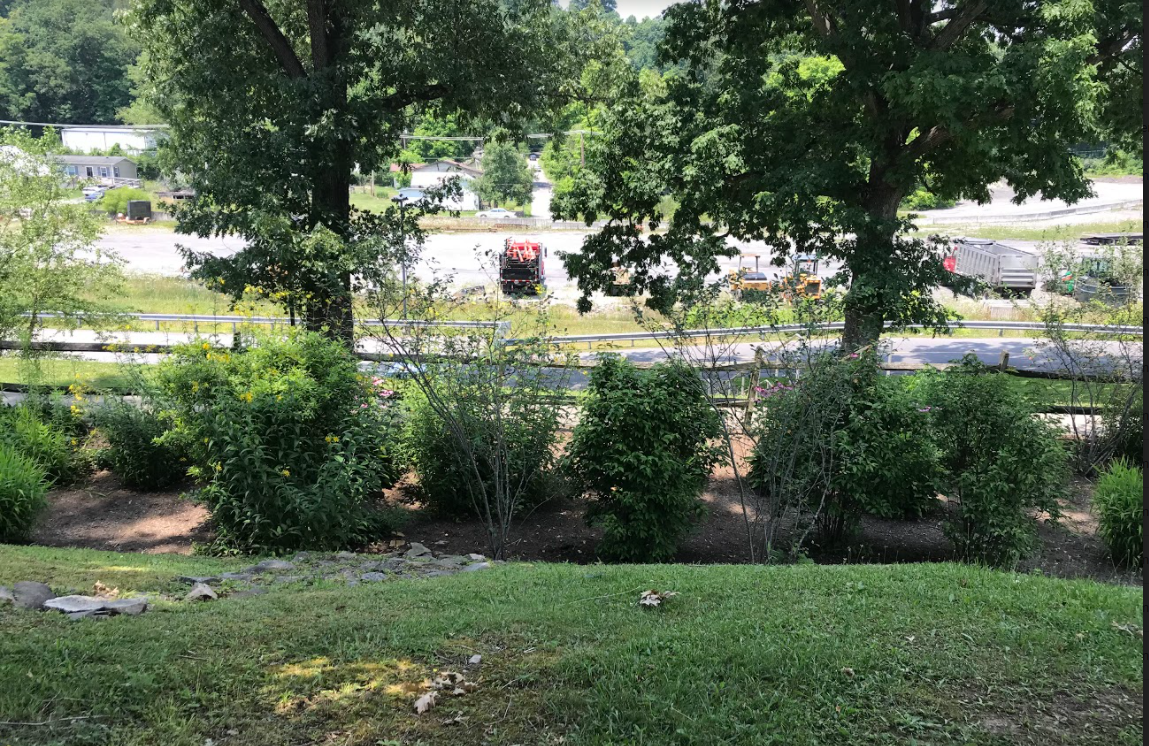 | A rain garden at the Beckley Exhibition Coal Mine Exhibit is an example of Green Infrastructure. In West Virginia and across the nation, stormwater runoff leads to localized nuisance flooding and polluted runoff that has negative impacts on water quality. In addition, climate change is resulting in more frequent and intense rainfall events as well as potential periods of drought. Green Infrastructure can help improve water quality and community resiliency by using plants, soils, and nature itself to manage stormwater and create healthier environments. Working with the New River Clean Water Alliance (NRCWA) and the WV Department of Environmental Protection’s Watershed Improvement Branch (WIB), a 319 Clean Water Act grant is being used to encourage and promote communities to use Green Infrastructure (GI) to treat stormwater for the southern region of West Virginia in the Lower New Watershed. The goal of this project is to recruit small communities in the Lower New River Watershed for GI assistance in the development of assessments, concept plans, designs and funding opportunities. Tetra Tech Inc. has been selected to help facilitate and create the conceptual GI plan working with the NRCWA starting in January 2022 and completed by the end of 2022. The way this project works, a workshop will be held with the community selected to identify the best locations and types of GI practices such as rain gardens, bioswales, and pervious pavement to help address stormwater concerns. Using maps and working with local decision-makers and landowners, a conceptual GI plan will be created and the first project will be identified and conceptual design created. The community will be assisted in finding funding to install the first GI project in their region and used as an example in the region to further the understanding of the environmental benefits and co-benefits of multiple green infrastructure practices, community decision-making with respect to preferred green infrastructure practices, and prioritization of areas for implementation, the preparation of concept plans and designs, and the identification of potential funding sources for implementation. | | | | Chemical Spill Funds Awarded to Six Watershed Groups | | 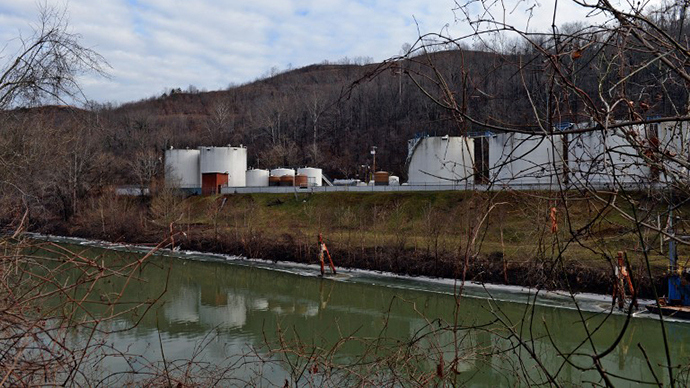 | Freedom Industry aboveground storage tanks along the Elk River. On January 9, 2014, 4-methylcyclohexane methanol (MCHM) leaked from Freedom Industry storage tanks into the Elk River, just above the water treatment plant operated by West Virginia American Water (WVAW). This unforgettable chemical spill disrupted the water supply of over 300,000 Charleston and surrounding area residents. Freedom Industry declared bankruptcy, a joint motion was filed and a class action settlement resulted. Years later, impacted businesses and residents were sent a check, but not all were cashed. Some of the funds that were left over from the class action settlement were reclassified into Cy Pres Awards, meaning they can be given to a charitable organization. In this case, the Cy Pres distributions can be awarded to specific organizations whose aim and purpose include the protection and restoration of watersheds in the nine counties impacted by the Freedom Industry Chemical Spill. Lawyers on the case, specifically Melissa Ellsworth, thought watershed organizations would fill this need and reached out to WV DEP’s Watershed Improvement Branch (WIB) to identify six watershed groups within the impacted area. On December 30, 2021, Honorable John T. Copenhaver Jr, the Southern District Court Judge of the Southern District Court of the United States, ordered that 60% of the Cy Pres funds ($1,051,424.99) be distributed to six watershed organizations. The remaining 40% was ordered to go to the West Virginia Land Trust. The recipients are outlined below: - Buffalo Creek Watershed Improvement Association (10%)
- Coal River Group (10%)
- Davis Creek Watershed Association (10%)
- Fourpole Creek Watershed Association (10%)
- Morris Creek Watershed Association (10%)
- Paint Creek Watershed Association (10%)
- West Virginia Land Trust (40%)
Each watershed group will receive the anticipated amount of $105,142.99 and work directly with WIB to submit a budget and workplan as if it were a Stream Partners Program grant, except that the use of the Cy Pres funds is solely (100%) for stream restoration, clean-up, and stream habitat rehabilitation. WIB will work with the watershed groups to complete projects within a three-year period beginning January 1, 2022, with the possible extension for a fourth or fifth year. All funds will be held in an escrow until the proposed budget and project work plan is approved by WIB. Watershed groups may engage in more than one project. WIB expects several wonderful watershed improvement projects and partnerships to result from this order. | | | | Outreach and Education on West Virginia's Wetlands | | | | | | The Watershed Improvement Branch in the West Virginia Department of Environmental Protection is working on outreach and education about West Virginia Wetlands (see the story in the previous WaterNet). One part of this plan is to compile information packets, including videos, about twelve wetlands across the state. In honor of those who might visit all of them, we are calling them “Collect-All-Twelve” or CAT wetlands. The selections are easier because there are relatively few that are on public land and have the infrastructure for visitors. Infrastructure, like a boardwalk, allows people to visit without trampling rare plants and possibly introducing disease organisms. Information packets and videos will recount why we visit wetlands; including why the water table is so shallow, what the soils are like, and what plants live there. We'll explain why those wetlands are so valuable, including their ability to buffer high and low flows, the way they improve water quality, and the habitat they provide for rare and special plants and animals. We are collecting some really special video footage and look forward to sharing it with you! | | | 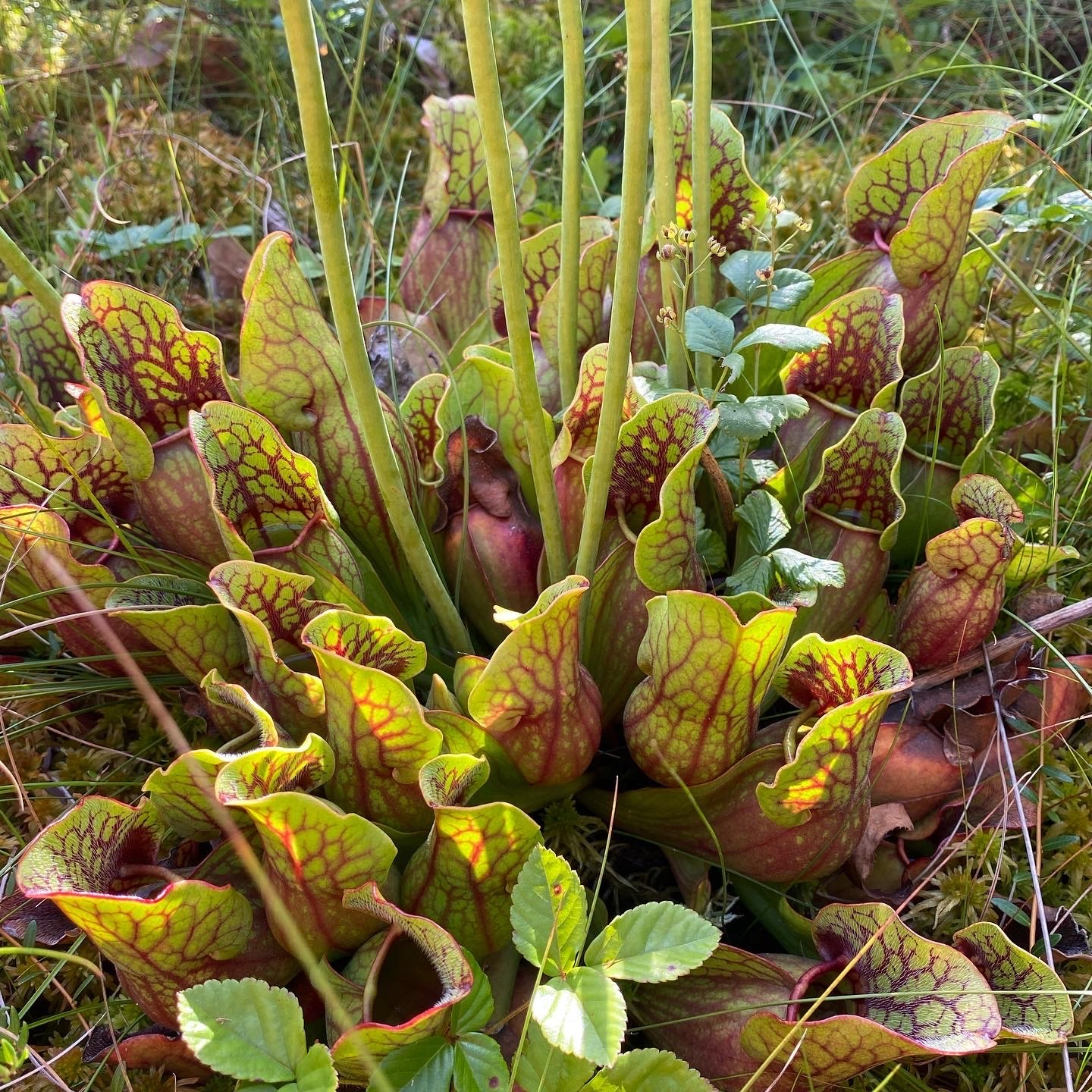 | Sarracenia purpurea, the pitcher plant. Photo: Frank Gebhard | | | | The following wetlands are included in the Collect-All-Twelve Wetland Program: | | | | McClintic WMA - Mason County Greenbottom Swamp - Cabell & Mason Cos. Kanawha State Forest - Kanawha County Wolf Creek - Fayette County Cranberry Glades -Pocahontas County Meadow River complex - Greenbrier County | | | | | West Virginia Botanic Garden - Monongalia County Cranesville Swamp - Preston County Alder Run Bog in Dolly Sods -Tucker County Widmyer Wetland - Morgan County Stauffer’s Marsh - Berkeley County Cool Spring Preserve - Jefferson County | | | | | | | | 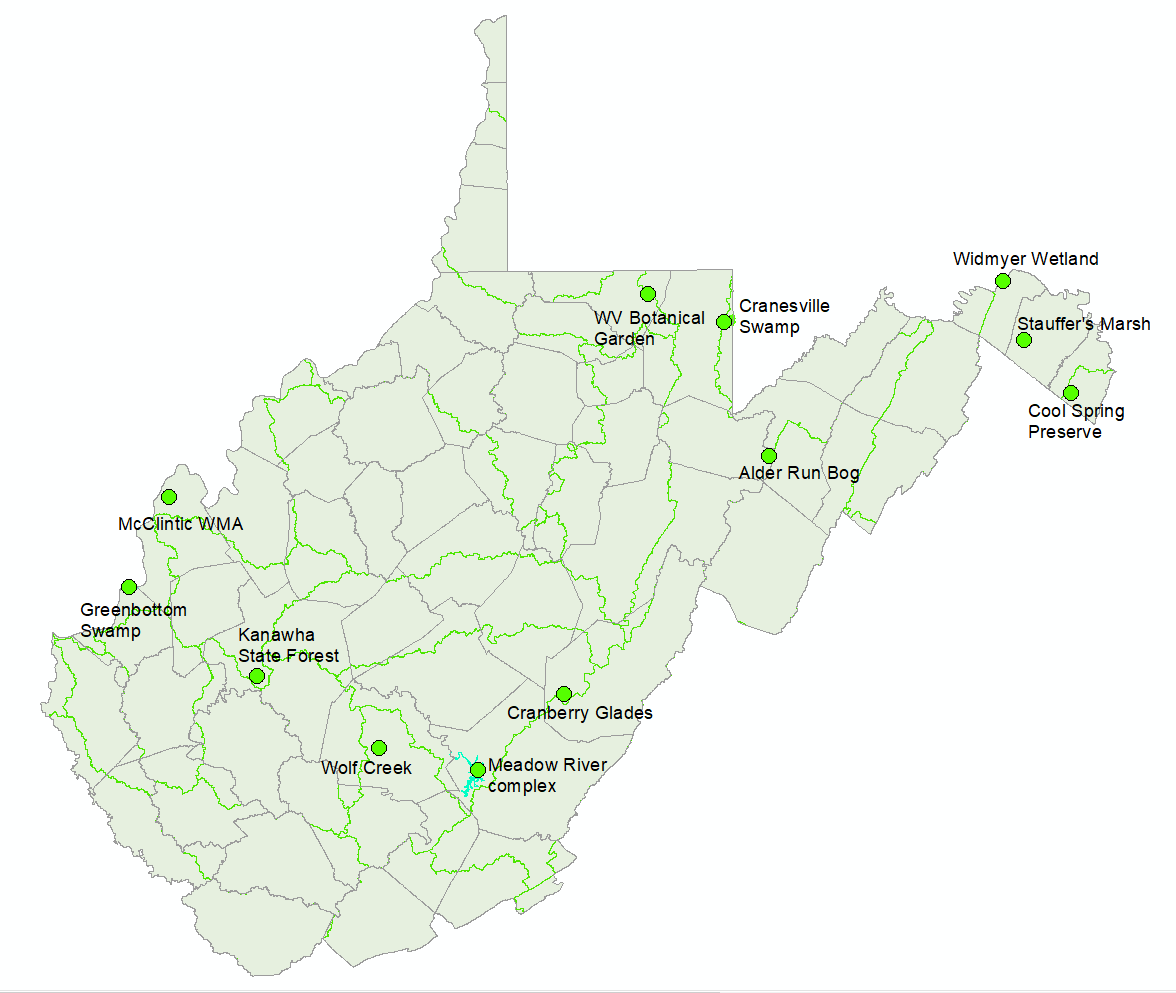 | | | | | Call for online wetland resources! The West Virginia Department of Environmental Protection’s (DEP) regional Basin Coordinators are updating DEP’s online wetlands resources page. We are looking for informative guides, fact sheets or manuals that will promote appreciation and enhancement of West Virginia’s wetlands. If you know of a great resource or video on this topic (resources from outside our state are fine if they are relevant enough), please share it with Alana Hartman at alana.c.hartman@wv.gov by January 31, 2022. We could use links about the functions and benefits of wetlands, their plants, animals, soils, and water; how to manage invasive plants; how to protect these valuable landscapes; materials for educators; and other resources you have enjoyed using. For inspiration, here is a video from Wisconsin Wetlands Association that we are excited to feature on the new webpage: “How wetlands manage water.” Thank you in advance for any help you can provide. | | Updated West Virginia Project WET Page! Do you need some water education in your life? Project WET’s mission is to advance water education to understand global challenges and inspire local solutions. Check out the new West Virginia Project WET (Water Education Today) page that details which educator workshops are offered, water event information, and water education resources! WV Project WET: https://dep.wv.gov/WWE/getinvolved/WET/Pages/default.aspx | | | | | | West Virginia Rivers Coalition
3501 MacCorkle Ave SE #129 | Charleston, West Virginia 25304
304-637-7201 | wvrivers@wvrivers.org | | The WV WaterNet is made possible through an award of Environmental Protection Agency’s 319 funding awarded to the West Virginia Rivers Coalition by the West Virginia Department of Environmental Protection. | |  | | | | | | | | |